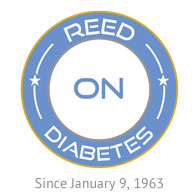Last week I posted about a fabulous experience buying jeans at Nordstrom. Here is the second part of the topic that delves into the customer and patient experience. That post ended with this question:
What if our experience with endocrinologists, educators, medical device, pharmaceutical, and insurance companies could be that amazing?
At first, this might seem like an unusual comparison. After all, a pair of jeans is a want. We buy them when we want, when they fit, and when we have the money.
Access to medical care for type 1 diabetes is a need. Insulin is required to live and predicated on relationships with doctors, educators, medical device companies, and insurance companies. It’s a complicated web, and in the U.S., the patient pays.
But our experience with diabetes care and consumer goods (like buying a pair of jeans) are influenced by these variables:
- Wait Time: The time to schedule, then the wait for a doctor’s appointment, and speed to answer in contact centers start our patient experience. Long delays can create frustration when an immediate connection makes us feel valued.
- Greeting & Communication Effectiveness: “How may I help you?” can be said enthusiastically or with apathy. How we are welcomed by receptionists, doctors, educators, and contact center representatives sets the tone for our experience. How our providers communicate conveys whether they are ‘walking with us’ or ‘working their metrics.’
- Knowledge Transfer: Diabetes care requires technical skills, and patients expect providers to be knowledgeable. Transferring that proficiency to patients with training and education is an art that solves problems and improves patients’ skills. This attribute is the magic sauce where providers can differentiate their care and products.
- Results: Type 1s seek help from medical providers and insurance companies to live well with diabetes. Performance against desired outcomes influences the patient experience. Achieving an A1C below 6.5 enhances our experience. Conversely, an A1C above 10 can leave us feeling frustrated and underwhelmed.
- Access to Information: A tech component is involved in the patient experience and enables access to information. It also assists with scheduling appointments, requesting prescriptions, and asking questions.
Now let’s compare my experience buying jeans at Nordstrom to my best-ever experience with each member of my diabetes medical care group:
|
Best-Ever Experience (1 – 5; 5 = High) |
|||||
|
Jeans @ Nordstrom |
Endocrinologists & Educators |
Medical Device Companies |
Pharmaceutical Companies |
Medical Insurance Companies | |
| Wait Time | 4 | 4 | 5 | N/A (*) | 5 |
| Greeting | 5 | 5 | 5 | N/A (*) | 5 |
| Knowledge Transfer | 5 | 3 | 5 | N/A (*) | 3 |
| Results | 5 | 5 | 5 | 4 | 3 |
| Access to Info | N/A | N/A | N/A | N/A | N/A |
| Average | 4.75 | 4.25 | 5.0 | 4.0 | 4.0 |
(*) N/A as the medical insurance company provides customer experience for insulin, and access to information wasn’t part of these one-time experiences.
But best-ever experiences are a moment in time. A better measure of patient experience is over time, especially with a persistent condition like type 1 diabetes. These are my anecdotal scores over the past year in each of the five areas:
|
Past 12-Month Experience (1 – 5; 5 = High) |
|||||
|
Shopping for Clothes |
Endocrinologists & Educators |
Medical Device Companies |
Pharmaceutical Companies |
Medical Insurance Companies | |
| Wait Time | 2 | 3 | 2 | N/A (*) | 3 |
| Greeting | 3 | 4 | 3 | N/A (*) | 2 |
| Knowledge Transfer | 3 | 2 | 2 | N/A (*) | |
| Results | 2 | 4 | 3 | 3 | 3 |
| Access to Info | 3 | 5 | 5 | 3 | 3 |
| Average | 2.5 | 3.25 | 2.5 | 3.0 | 2.75 |
(*) N/A pharmaceutical customer experience is provided by medical insurance companies.
What a difference between the scores at a moment and over time!
My providers have some work to do with the experience they provide (as do retailers). With endocrinologists as the focal point for the other groups, it’s reassuring to see that they score the highest.
In future posts, I’ll examine each of the five variables influencing our type 1 experience. As I write, I’ll do so in my fabulous new pair of jeans 🙂
Additional Notes:
- I have designed and delivered the customer experience, and it’s easy to find moments when customers and patients are thrilled with their experience. The challenge is to provide an extraordinary experience consistently. It is attainable, and the ingredients include the voice of the customer/patient, six sigma, talent acquisition and retention, technology, and a results discipline.
- Anecdotal scoring is based on personal observation, not data sources. I believe my assessment is reasonable, having worked 30+ years in customer experience and 60+ years of consuming diabetes care. If this were a study on patient experience, I would employ source data.
- I opted not to include price as a variable in the patient experience. Price influences our buying decision and perception of value. However, once we buy a product or service, we expect it to work … especially when it’s required to live well with a persistent condition like type 1 diabetes. Even as the price of insulin increased dramatically over the past decade, it didn’t change my experience with insulin: it worked as expected, and I received it when needed. What changed was my perception of pharmaceutical companies and insurance companies that profited at our lifeline. I can only imagine what Sir Frederick Banting, the co-discover of insulin, would think. Dr. Banting would not only be appalled, he would also ask for his dollar back.
**************************

